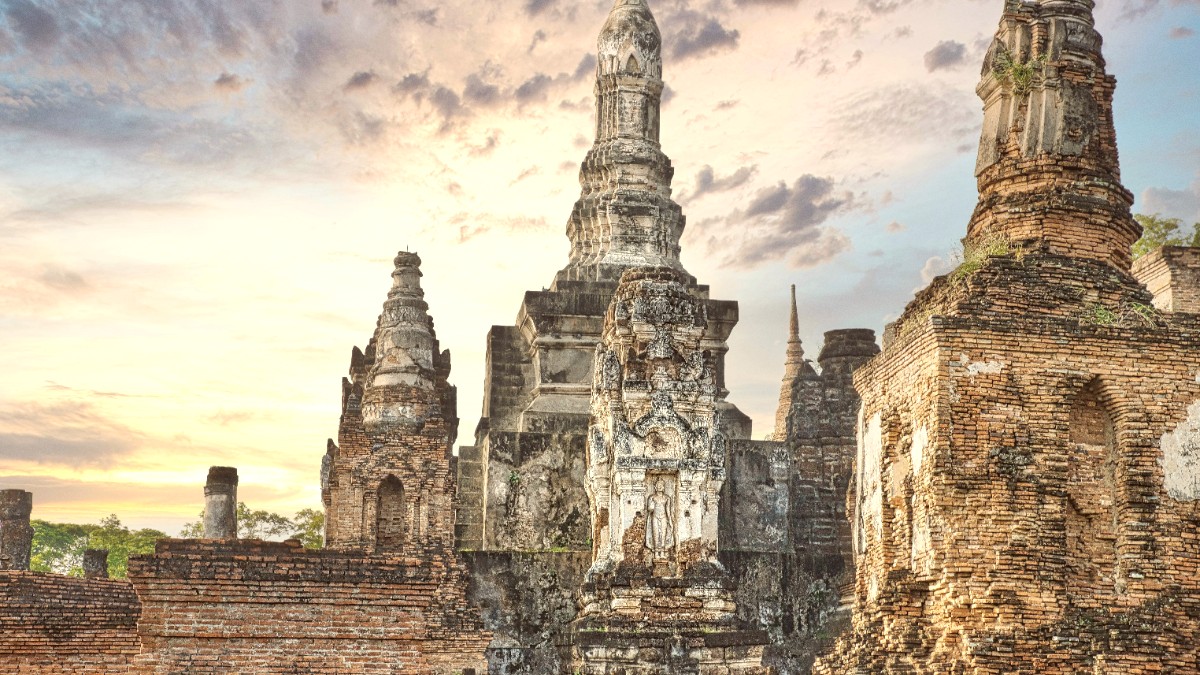
Sukhothai Province, Thailand
The Sukhothai Historical Park is the main draw, housing a collection of iconic landmarks that showcase the kingdom's grandeur and artistry.
This vast park preserves the ruins of the former capital of the Sukhothai Kingdom. It separates into central, northern, western, eastern, and southern zones, each containing significant structures. The central zone, dense with important monuments, typically serves as the starting point for visitors.
Carry plenty of water, dress modestly for temple visits (shoulders and knees covered), and visit early morning or late afternoon for fewer crowds.
A smaller, private museum focusing on local history, traditional tools, and artifacts of the Sukhothai region. Offers an intimate look at daily lives, sometimes open by prior arrangement.
In November, the Sukhothai Historical Park becomes a major cultural center. It hosts elaborate light-and-sound shows, traditional dance, and cultural parades, recreating the ancient kingdom's atmosphere. This is the peak time for cultural performances.
There are no regular, year-round dedicated performance venues for traditional arts outside of these special events. Some larger hotels might occasionally arrange small-scale performances.
These events and local museums provide engagement with Sukhothai's rich heritage.
The park itself represents a vast historical district with unique Sukhothai-style architecture.
Sukhothai is synonymous with historical sites, mainly its magnificent Historical Park and other nearby ancient cities. These sites provide a tangible connection to Thailand's past.
The main archaeological site, with dozens of temples, palaces, and structures. Each zone offers insight into the kingdom's architecture, religion, and daily life.
About 50 km north, an UNESCO site that served as a twin city to Sukhothai, with well-preserved temples and ancient kilns.
Further south, an UNESCO site displaying impressive ruins from Sukhothai Kingdom's later period, built with brick and laterite.
Characterized by elegant lotus-bud chedis, graceful walking Buddha images (a distinct innovation), and Sri Lankan influences.
All Wats (temples) within the Historical Park, even in ruin, hold profound spiritual meaning, once centers of Buddhist learning.
New City also has active temples like Wat Ratchathani, serving local communities.
A large and revered statue within the central zone of the Historical Park, honoring the king credited with creating the Thai alphabet and establishing enduring traditions.
The entire Sukhothai Historical Park forms a sprawling historical district, reflecting a period of great artistic and spiritual development.
The ruined Wats within the park, and active temples in New City, remain centers of Buddhist worship and spiritual life.
While Sukhothai is celebrated for its historical sites, the surrounding region also presents natural beauty and opportunities for outdoor enjoyment.
The expansive, well-maintained grounds of Sukhothai Historical Park offer a park-like feel with ponds and ancient trees, ideal for cycling and picnics. Ramkhamhaeng National Park (west of Sukhothai) offers a mountainous contrast with diverse flora and fauna.
Wat Saphin Hin, a hilltop temple, provides the best panoramic view of the Sukhothai Historical Park, capturing the vast expanse of ruins, especially at sunrise or sunset. Khao Luang in Ramkhamhaeng National Park offers expansive views from the highest peak in Sukhothai Province.
Ramkhamhaeng National Park presents birdwatching and small mammal spotting opportunities. Sukhothai is inland with no beaches; the Yom River runs through, and the park's ponds are aesthetic and part of ancient water management.
Ramkhamhaeng National Park offers challenging treks to Khao Luang for panoramic views, alongside shorter, easier trails to waterfalls like Sai Rung Waterfall.
Explore TrailsThe premier cycling destination with extensive, flat, and well-maintained paths connecting all major temples. Bicycles are easily rented at the park entrance and from guesthouses.
Bike ToursQuiet rural roads outside the city present a peaceful glimpse into local village life and agricultural landscapes, observing rice paddies and traditional homes.
Ramkhamhaeng National Park offers opportunities for birdwatching and spotting smaller mammals within its forested areas with quiet observation.
Water sports are limited as Sukhothai is an inland province. No significant lakes for water sports or coastal beaches.
The Sukhothai Historical Park embodies the rise of an ancient kingdom, showing architectural innovations and artistic developments unique to its era. Each ruin tells a story of a thriving past.
The park's open spaces and the national park's forests contrast with the historical ruins, creating a holistic environment for both cultural and natural appreciation. Respect natural surroundings during visits.
Plan your visit to the Historical Park to include both popular and less-visited sites.
Allocate enough time to fully appreciate the scale and beauty of the ruins. Staying near the park offers easy access for early morning or late afternoon visits.
Beyond the well-known landmarks, Sukhothai presents a few hidden gems and local favorites that provide a quieter, less crowded experience.
These sites offer a more contemplative and intimate exploration, often overlooked by visitors focusing on the central park areas.
These destinations offer cultural immersion and a connection with Thai rural culture beyond the historical park alone.
These spots capture the essence of Sukhothai's history and natural beauty in unique ways.
Bring a wide-angle lens for the full effect.
Sukhothai's serene ponds mirror its ancient wonders, offering tranquil and picturesque scenes.
Consider a tripod for low-light shots.
Cycling through the Historical Park offers endless opportunities for scenic shots of ruins amidst nature.
Look for local life alongside the ruins.
Located north of Sukhothai, it receives fewer visitors but offers equally rich historical experiences. It is an UNESCO site with well-preserved temples and ancient kilns.
Further south, also an UNESCO site, it displays impressive ruins from the Sukhothai Kingdom's later period, characterized by brick and laterite construction. It is worth the effort to visit.
These sites provide opportunities to explore more of the Sukhothai Kingdom's influence and artistic reach beyond the main park, with fewer crowds.